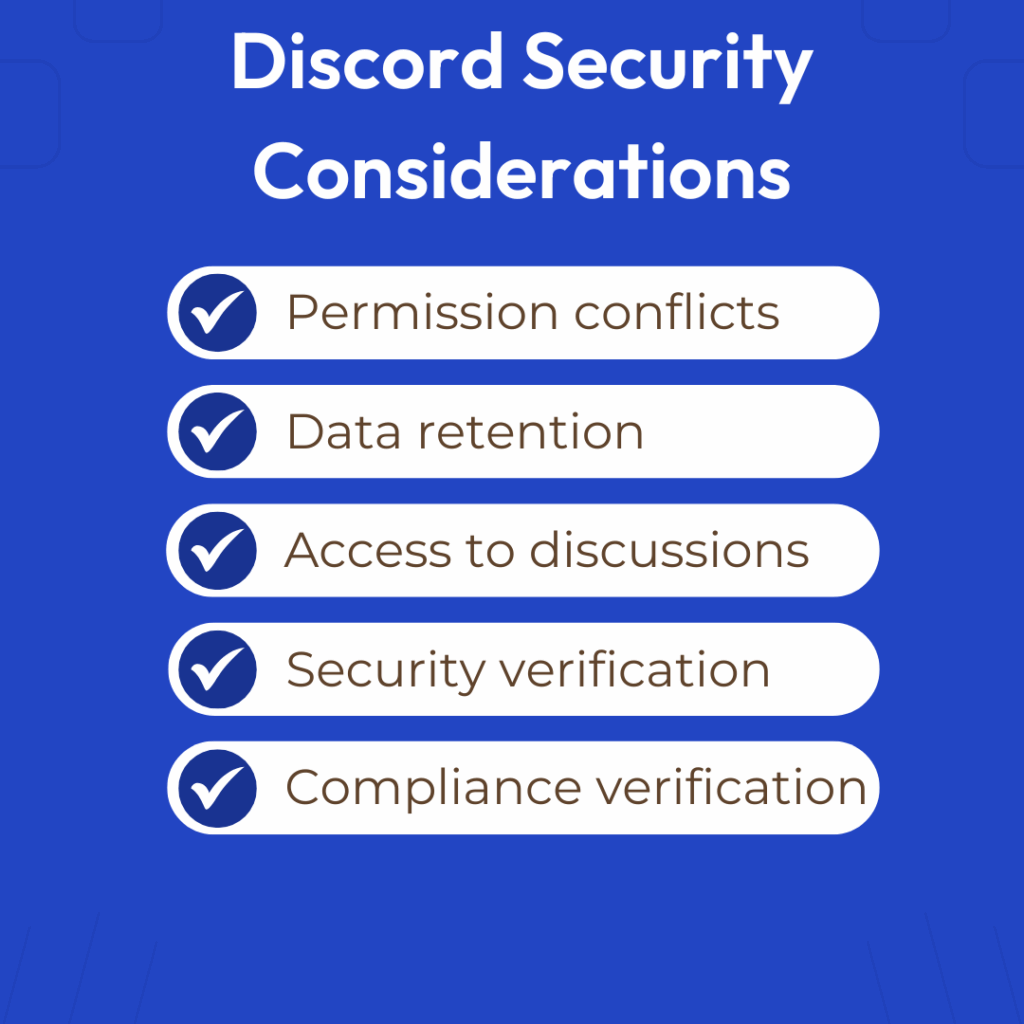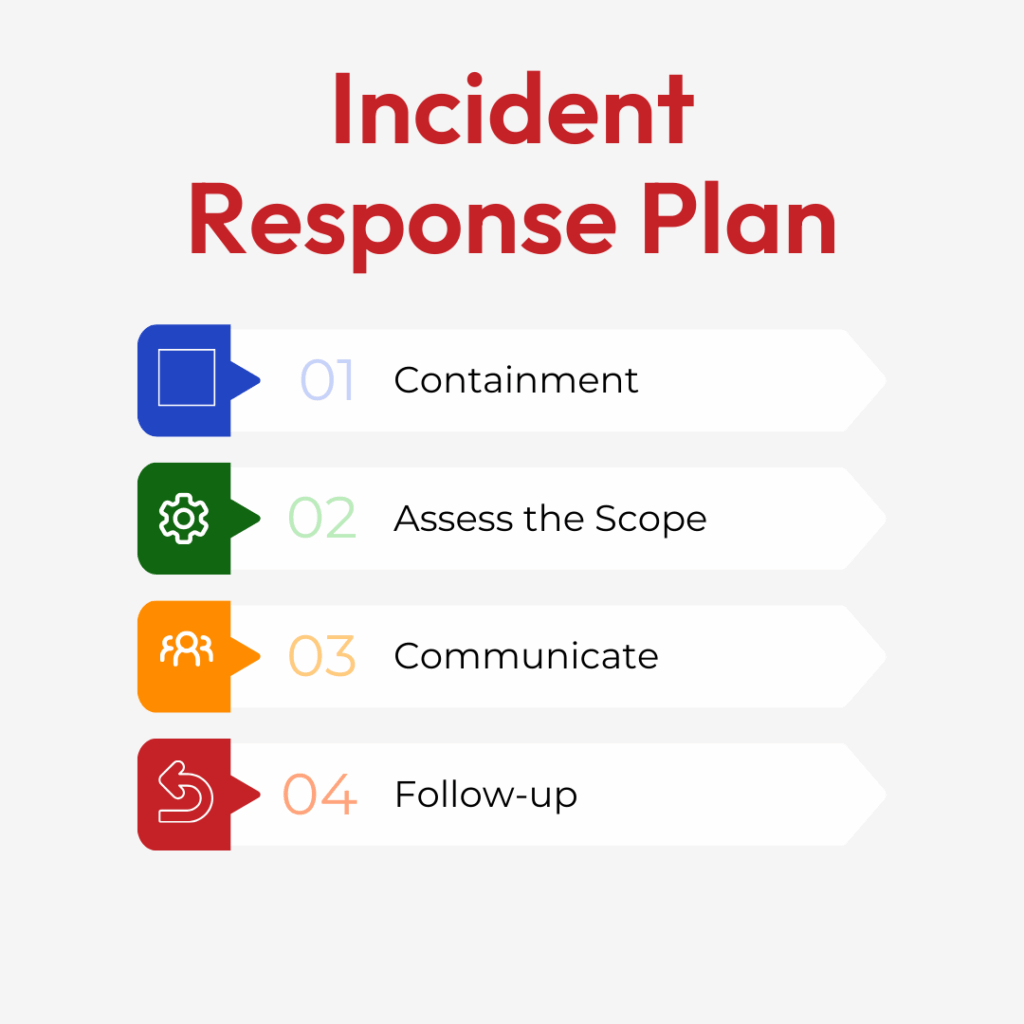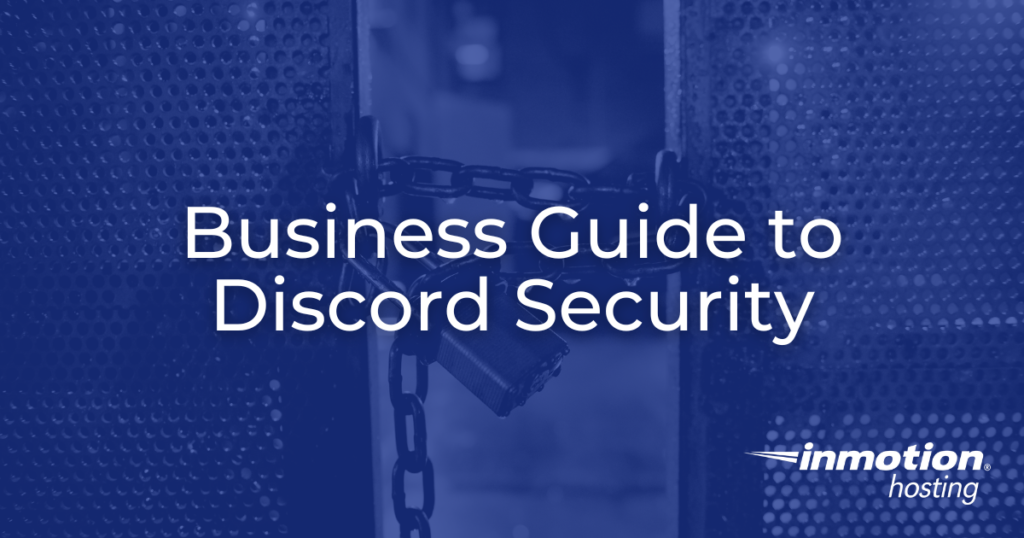Protect your business from cyberthreats with this comprehensive Discord security guide. Learn essential account protection strategies, server configuration best practices, and advanced security measures tailored for development teams, client communications, and remote collaboration. Implement proper bot management and incident response plans to safeguard your sensitive business communications from increasingly sophisticated attacks.
If you are a business leader who is using Discord regularly, the security aspects of discord likely need your attention. Although it’s a great, cost-effective platform for community, customer support, internal comms and more, there are also some security measures that you need to take into consideration.
Think about your work conversations on Discord. You share project plans, talk about customers, and discuss company information. All of this sits on Discord’s servers, protected by the passwords your team creates.
Discord is a great tool for communication, but it wasn’t originally built for businesses. It was made for people playing video games who wanted to chat. This means the security features work differently than other business tools you might use.
As a business leader, it’s smart to understand how Discord security works and what steps you can take to protect your company’s information. The good news is that you can keep your team communicating effectively while also keeping your business data safe.
So what should you know about Discord security? And how can you make sure your company is protected?
The True Cost When Discord Security Fails
Financial losses from poor Discord security extend far beyond immediate theft. They cascade through your business in waves, each more damaging than the last.
Initial Breach Costs
The first wave hits immediately. Incident response costs start at $50,000 for small breaches. You need forensic investigators to determine what was accessed. Lawyers to assess liability. PR firms to manage communication. IT consultants to rebuild security. These expenses appear within hours of discovery.
Client Trust
The second wave arrives with client reactions. Trust, once broken, rarely returns to previous levels. Clients who stay often demand discounts as “compensation” for their risk. New security audits become contract requirements. Insurance premiums double or triple. Some insurers simply refuse coverage.
Long-term Effects
But it’s the third wave that destroys businesses. This is when the full scope becomes clear. Intellectual property appears in competitor products. Strategic plans lose their advantage because everyone knows them. Employee morale crumbles as private conversations surface. Recruitment becomes nearly impossible when candidates research your security history.
PBS learned this lesson in an unexpected way. Their Discord breach didn’t look like a typical business attack. Hackers didn’t steal the data for money. Instead, young fans on PBS Kids Discord servers shared employee information just because they thought it was interesting.
The data included names, work emails, job titles, and other details for almost 4,000 PBS employees. Kids and teenagers passed it around not to make money, but because having the information seemed “cool” to them.
Even though the breach started from curiosity rather than crime, PBS still had to deal with serious problems. They had to investigate what happened, tell all affected employees, and worry about how the information might be misused later.
These stories show how Discord security works differently than other business tools. Data can spread in unexpected ways and for unexpected reasons. Remember that every unsecured server creates risk as do weak passwords and security gaps.
The lesson isn’t that Discord is bad for business. It’s that business leaders need to understand how security works on the platform and take the right steps to protect their teams and information.
Understanding Discord’s Security Model
To protect your business, you need to understand Discord’s architecture. More specifically, you need to understand why its design creates unique vulnerabilities for business users.
Discord’s foundation assumes good intentions. The platform was built for communities where members want to be there. Where trolls get banned quickly. Where the biggest threat is someone posting spoilers for the latest game. This trust-based model shapes every security decision.
Here’s what catches businesses off guard about Discord’s architecture:
Permission conflicts create gaps: Server permissions, role permissions, and channel permissions interact unpredictably. Add a scheduling bot to your executive channel? That bot now sees strategic discussions. Remove someone’s channel access? Discord’s caching lets them screenshot messages for hours afterward.
Data never truly disappears: Delete a message? It vanishes from view but lives on Discord’s servers indefinitely. Remove a file? Its URL keeps working forever. This persistence becomes a compliance nightmare.
Discord reads everything: Your messages travel encrypted to Discord, but Discord itself has full access. They scan for violations. They process for search. They analyze for features. Your confidential discussions are readable by their systems and potentially their employees.
You can’t verify security: Discord controls everything server-side. You can’t audit their procedures. You can’t verify their controls. You can’t ensure compliance. You’re trusting completely without any way to verify that trust.

This isn’t necessarily malicious. Discord needs these capabilities to provide their service. But it means your data security depends entirely on Discord’s internal controls, and you have zero visibility into how well they protect your business communications.
So, how can you secure your Discord servers? We’ll break it down for you.
Building Your Discord Security Foundation
Start with stronger authentication
Every business Discord account needs more protection than just a password. The best first step is setting up two-factor authentication, but not all types work the same way.
SMS codes (texts to your phone) seem secure, but they have problems. Phone companies can be tricked into giving your number to someone else. Instead, use an authenticator app like Google Authenticator, Authy, or Microsoft Authenticator.
These apps create new codes every 30 seconds that work even when your phone is offline. Nobody can steal them by taking over your phone number. Setting this up takes about five minutes and stops most attacks.
Use unique passwords everywhere
Using the same password for Discord and other accounts is risky. If hackers get into one account, they can access all your others. But remembering dozens of different passwords is hard.
That’s where password managers help. Tools like 1Password, Bitwarden, or Dashlane remember all your passwords for you. They also create strong, random passwords and warn you if any of your accounts get breached.
Keep your software updated
Discord regularly releases security updates. Set your Discord app to update automatically so you always have the latest protection.
Review who has access
Check your server settings regularly. Remove people who no longer work with your company. Make sure only the right people can access sensitive channels.
Train your team
Teach your employees about phishing attempts and suspicious links. Most Discord security problems start when someone clicks something they shouldn’t.
These steps don’t take long to set up, but they make your business much safer on Discord.
Configuring Discord Servers for Business Protection
With authentication secured, we turn to server configuration. This is where Discord’s flexibility becomes both an asset and a liability. You can configure servers for excellent security. But default settings leave you exposed.
Verification Levels
Start with verification levels. Discord offers five options, from no verification to maximum security. Most businesses choose low verification for convenience, but this is a mistake that invites automated attacks and spam.
High verification requires a verified phone number and ten minutes on your server before messaging. Yes, this slows down new member onboarding. But that ten-minute delay filters out most automated attacks. Real employees will wait where bots won’t. It’s a simple filter that dramatically improves your Discord security posture.
Roles and Permissions
Next comes the critical decision about roles and permissions. Most businesses create too few roles with too many permissions. Everyone gets similar access because it’s easier to manage. But this convenience creates massive vulnerability.
Think about your physical office. The receptionist doesn’t have keys to the server room. The cleaning crew can’t access the safe. Different roles require different access levels. Discord should mirror this reality.
Create roles that match your organization structure. Developers need different access than sales. Contractors require less permission than employees. Executives need private spaces for sensitive discussions. Each role should have exactly the permissions required, no more.
This granular approach contains breaches. When an account gets compromised, hackers can only access what that role permits. They can’t escalate privileges easily. They can’t move laterally through your entire organization. The breach remains contained to one area instead of spreading everywhere.
Channel organization supports this containment strategy. Don’t dump everything into a few general channels. Create specific channels for specific purposes. Public channels for announcements. Team channels for collaboration. Private channels for sensitive discussions. Archive channels for completed projects.
This organization isn’t just about security. It improves productivity too. Conversations stay focused. Information remains findable. New employees understand where to communicate. But most importantly, when Discord security fails, damage stays limited to specific areas.
Managing Third-Party Integrations and Bots
Now we reach Discord’s most dangerous feature for businesses: third-party integrations. Every bot you add increases your attack surface and whenever you build a webhook it creates a potential data leak. Keep in mind that every integration introduces dependencies you can’t control.
Bots
The solution isn’t avoiding bots entirely. It’s treating them like you’d treat any vendor with office access. You wouldn’t give building keys to every service provider. Don’t give Discord permissions to every bot that asks.
Start with a bot approval process. Before adding any bot, document its purpose. Research its developer. Check its permission requirements. Test it in a sandbox server first. Set a review date to reassess its necessity. This process takes time, but prevents catastrophic Discord security failures.
For bots you do approve, minimize permissions ruthlessly. If a bot works with reduced permissions, never grant more. If it demands administrator access for basic functions, find an alternative. Good bots request minimal permissions. Suspicious bots demand everything.
Webhooks
Webhooks present similar challenges. They’re incredibly convenient for automation. Post alerts from other services. Share updates from project management tools. Integrate with countless platforms. But each webhook is a door that opens both ways.
When you create a webhook, you’re trusting external services with direct access to your Discord. If those services get compromised, attackers can post anything to your channels. Malware links. Phishing attempts. Misinformation. All appearing to come from trusted sources.
Even worse, webhooks can exfiltrate data. A compromised webhook doesn’t just post to Discord. It can forward your messages elsewhere. Every conversation in that channel might be copying to external servers. You’d never know without detailed monitoring.
Creating a Security-First Communication Culture
Technology alone won’t protect your Discord communications. The best security tools fail when people bypass them. Real protection comes from building security awareness into daily habits.
This cultural shift starts with leadership. When executives take Discord security seriously, teams follow. When management treats security as optional, nobody cares. The tone from the top determines whether security succeeds or becomes expensive theater.
But preaching about security doesn’t work. People tune out lectures about password complexity and phishing awareness. They’ve heard it before. They think they know the risks. They believe they’re too smart to fall for attacks.
Instead, make security personally relevant. Share stories from similar companies. Discuss real breaches in your industry. Calculate what a breach would cost your specific organization. When security becomes tangible rather than theoretical, people pay attention.
Training Frequency
Training should be continuous, not annual. Discord security threats evolve monthly. Last year’s training is already outdated. New attack methods emerge constantly. Your team needs current information to stay protected.
But don’t overwhelm people with constant warnings. Integration beats intensity. Add security tips to existing communications. Start meetings with brief security reminders. Include security updates in team newsletters. Make security part of the conversation, not a separate burden.
Use Recognition
Recognition motivates better than fear. Celebrate employees who report suspicious activity. Thank people who question unusual requests. Share success stories of prevented attacks. When security becomes associated with praise rather than problems, participation increases.
The most critical element is psychological safety. Employees must feel safe reporting mistakes. If clicking a phishing link means punishment, nobody admits errors. Breaches go unreported until damage becomes undeniable. Create an environment where admitting mistakes is encouraged, not punished.
When Discord Can’t Meet Your Security Needs
Despite your best efforts, Discord might not suit your security requirements. Recognizing these limitations isn’t failure. It’s responsible risk management.
Healthcare Organizations
Healthcare organizations face immediate challenges. HIPAA requires specific safeguards Discord doesn’t provide. Audit logs must track every access to protected information. Data must be encrypted at rest with controlled keys. Deletion must be verifiable and complete. Discord offers none of these capabilities.
Financial Services
Financial services encounter similar obstacles. SEC regulations require archiving all business communications. Every message must be retained for years. They must be searchable for audits. They must be producible for legal discovery. Discord’s data management doesn’t support these requirements.
Government Contractors
Government contractors face even stricter limitations. Classified information requires air-gapped systems. Controlled unclassified information needs specific handling procedures. International Traffic in Arms Regulations prohibit certain technical discussions. Discord’s cloud-based architecture violates fundamental security requirements.
Other Considerations
But even unregulated businesses might outgrow Discord. As companies scale, security needs intensify. What worked for ten employees fails for a hundred. What sufficed for domestic operations breaks with international expansion.
The decision to migrate isn’t easy. Your team knows Discord. They’re productive using it. Alternative platforms require training. Migration disrupts workflows. But staying on an inadequate platform risks everything you’ve built.
The migration itself needs careful planning. Don’t just announce a platform change. Explain why it’s necessary. Provide comprehensive training. Run both platforms in parallel initially. Migrate gradually to minimize disruption. Most importantly, preserve important data before shutting down Discord.
Building Your Incident Response Plan
Even with excellent Discord security, breaches can occur. Your response in those first hours determines whether it’s a minor incident or a major catastrophe.
Preparation starts with detection. How will you know about a breach? Don’t rely solely on automated alerts. They help, but sophisticated attackers disable monitoring. Train your team to recognize subtle signs.
When you suspect a breach, speed matters but panic kills.
Your first instinct might be alerting everyone immediately. Resist this urge. Broad announcements warn attackers you’re aware of them. They might accelerate data theft or destroy evidence. Sometimes silent investigation serves better than loud alarms.
Step 1: Containment
Start with containment. Isolate affected accounts without alerting attackers. Change passwords from a secure device. Revoke all active sessions. Review recent account activity. Document everything you find. These first steps stop ongoing damage while preserving evidence.
Step 2: Assess the Scope
Next, assess the scope. What channels could attackers access? What information was available? Who else might be affected? Understanding breadth guides your response. A single compromised account requires different actions than server-wide infiltration.
Step 3: Communicate
Communication during incidents requires careful balance. Legal obligations might require immediate notification. But premature announcements can worsen damage. Coordinate with legal counsel. Prepare clear, accurate statements. Avoid speculation or blame. Focus on facts and actions being taken.
Your response team needs clear roles defined in advance. During a crisis, confusion amplifies damage where clear responsibilities prevent costly delays.

Your Discord Security Implementation Timeline
Knowledge without action is worthless. Here’s your practical timeline for implementing robust Discord security that actually protects your business:
Immediate Actions (Do Today)
Enable two-factor authentication on every business account – it takes five minutes
Remove Discord access for all former employees and contractors
Change your Discord password if you’ve used it anywhere else
Download an authenticator app if you’re still using SMS codes
Week One Priorities
Audit who has administrative privileges and reduce to 2-3 people maximum
Document all current bot permissions and remove unnecessary ones
Create separate channels for different security levels (public, private, confidential)
Set server verification to high for all business servers
First Month Goals
Deploy password managers to your entire team with training
Establish weekly security tips in team communications
Create and test your incident response procedures
Review and minimize all role permissions to least-privilege levels
Quarter One Milestones
Complete security awareness training for all staff
Run a simulated breach exercise to test responses
Evaluate whether Discord meets your compliance needs
Build regular security reviews into your monthly workflow
This timeline turns overwhelming security improvements into manageable steps. Each phase builds on the previous one, creating momentum toward comprehensive protection. Miss these deadlines, and you’re actively choosing to remain vulnerable.
The Choice You’re Making Today
InMotion Hosting knows that businesses need safe communication tools that actually work. We’ve helped thousands of companies use Discord securely while keeping their teams connected and productive.
The good news is that securing Discord doesn’t have to be complicated. The right tools are available, and the steps are straightforward. You just need to take action.
Here’s what you can do today:
Set up those authenticator apps for your team. Create a password manager policy. Update your Discord settings. Review who has access to what channels.
These aren’t huge changes, but they make a real difference. Your business communication can be both easy to use and secure.
You’ve got this
Your team relies on Discord to get work done. With the right security steps in place, you can keep using it confidently. Take a few minutes today to strengthen your setup. Your business will be better protected, and your team can focus on what they do best.
The tools are ready. The steps are clear. Now it’s time to make your Discord as secure as it is useful.

